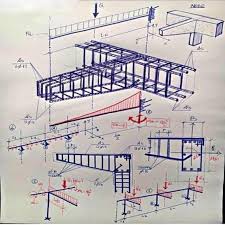Interested in Becoming a Structural Engineer – Learn What it Takes
Table of Contents
 Structural engineering is the sub-discipline of civil engineering that focuses on designing the appropriate structural element used to create the shape and form of manmade structures.Currently, the state of Texas is a generic licensure jurisdiction – meaning they do not require structural engineers to obtain a specific license for their discipline. Structural engineers in Texas take the SE exam, and the TBPE will record their discipline as being structural.
Structural engineering is the sub-discipline of civil engineering that focuses on designing the appropriate structural element used to create the shape and form of manmade structures.Currently, the state of Texas is a generic licensure jurisdiction – meaning they do not require structural engineers to obtain a specific license for their discipline. Structural engineers in Texas take the SE exam, and the TBPE will record their discipline as being structural.
Structural engineers must understand and be able to calculate which structural elements give a boat the strength, stability and rigidity it needs to stand up wind, waves, water, storms and other environmental and human pressures that are brought to bear on it during everyday use. Structural engineers work closely with architects and other engineers to ensure the boat’s structural integrity will enable it to be used safely, effective and efficiently. The Texas Board of Professional Engineers is responsible for licensing engineers in the state. Check out our continuing education courses for structural engineers.
Knowledge Base Required For Effective Structural Engineering
Structural engineers must understand the theories behind applied physical laws. They must also have empirical knowledge of different materials and geometries structural performance. Structural engineering design requires the use of several structural elements that are relatively simple to build boats with complex structural systems. The structural engineer is responsible for creatively and efficiently using materials, structural elements and funds to design boats that are seaworthy, durable, attractive and have all the appropriate engineering elements and creature comforts to function effectively.
What Does A Structural Engineer Do?
In the boating industry, structural engineers work to develop effective designs and help to construct and maintain the vessels. Their main goals is ensuring constructional and architectural integrity for boats of all types. They work to make sure the boats can withstand any type of stress to which it can reasonably be subjected. Safety, efficiency and functionality are paramount to structural engineers even as they focus their attention on the initial design, construction and cost of the boat.
Key Skills Required
 Good structural engineers must have and use excellent problem-solving and decision-making skills at every stage of the complex boat designing and building projects. Effective design requires their use of calculus, trigonometry and other math skills during the design process. Structural engineers also require good writing skills, as they must prepare reports for architects and the teams involved in actually fabrication the boats. Providing clear and concise information are important keys to ensure the completed boats meet all the essential requirements for proper structural integrity and functionality.
Good structural engineers must have and use excellent problem-solving and decision-making skills at every stage of the complex boat designing and building projects. Effective design requires their use of calculus, trigonometry and other math skills during the design process. Structural engineers also require good writing skills, as they must prepare reports for architects and the teams involved in actually fabrication the boats. Providing clear and concise information are important keys to ensure the completed boats meet all the essential requirements for proper structural integrity and functionality.
A Variety Of Duties
As the construction of the boats go through different phases, the duties of the structural engineer changes. During the design phase their duties include using their understanding of theoretical concepts, as well as practical knowledge to ensure the boat they design will maintain its structural integrity no matter what external forces act on it. The structural engineer must then take on cost estimate duties for the project. That includes reconciling budgetary constraints with the cost of the labor and materials need to build the boats. During the construction phase, the duties of the structural engineer change to supervising and inspecting the execution of blueprints, as well as their design’s implementation. They must communicate technical data to managers and construction engineers to pass on to builders and laborers.
What Is The Difference Between A Civil Engineer And A Structural Engineer?
Even though structural engineering is a sub-set of civil engineering, there are several differences between the two positions. While civil engineers focus on the safety, stability and cost-effectiveness of the design and construction of a boat, structural engineers also look at the impact wind, rain, waves, temperature and other forces will have on the materials that go into constructing it and how it will stand up to wear and tear over time. Structural engineers also focus on the proper maintenance of the boats to ensure the structure will remain intact.
What Qualifications Should A Structural Engineer Have?
In order to become a structural engineer, a student must first successfully complete a four year civil engineering program at an accredited college or university and get a bachelor’s degree. The engineer must then go on to do postgraduate structural engineering studies and earn a master’s degree or a PHD with a specialization in structural engineering. That usually requires an additional two to four years of study in this advanced specialization before you can be qualified to become a structural engineer.
Licensure
Once the candidate who wishes to become a structural engineer has completed their bachelor’s degree in civil engineering or their masters and PHD in structural engineering, in order to practice in Texas or any other state they are required to pass the Professional Engineer (PE) licensing exam. This exam tests their knowledge of engineering fundamentals. Once they pass the exam, they must then complete a civil engineering internship or become an engineer-in-training. Some states have additional requirements candidates must meet before receiving a professional license as a civil engineer. The Texas Board of Professional Engineers and Land Surveyors has a comprehensive FAQs for requirements to become licensed.
Structural Engineering License
In addition to the PE license, engineers wishing to work as structural engineers are required to hold a structural engineering license or S.E. To earn their SE, structural engineering applicants must take a 16-hour structural examination offered by the NCEES. The exam has two parts, lateral and vertical portions. Engineers must pass both portions of the exam. Both sections of the test must be successfully completed within a 5-year period. Should an engineer only one component of the SE exam during a 5-year period, the exam results from the component they did pass is invalidated. In order to get their SE license, they must retake and pass both SE exam components.
What Is The Difference Between PE And SE?
 There are significant difference between the PE and SE licenses. The PE license is the basic civil engineering license all civil and structural engineers are required to have to perform boat building design work. In some states it is referred to as a Registered Professional Engineers license. To earn it engineers must have completed their civil engineering bachelors degree program, have four years of experience, as well as have passed the 8 hour long Fundamentals of Engineering exam, along with the 8 hour long Professional Engineers exam.
There are significant difference between the PE and SE licenses. The PE license is the basic civil engineering license all civil and structural engineers are required to have to perform boat building design work. In some states it is referred to as a Registered Professional Engineers license. To earn it engineers must have completed their civil engineering bachelors degree program, have four years of experience, as well as have passed the 8 hour long Fundamentals of Engineering exam, along with the 8 hour long Professional Engineers exam.
The SE License
Texas and approximately 13 other states issue S.E. licenses. The requirements to hold those licenses vary significantly. In some states, civil engineers must have 2 to 4 years of additional progressive structural experience after passing the P.E. exam before taking the S.E. exam. This exam is between 16 and 20 hours long. The civil engineer must be much more experienced and qualified to earn an S.E. license. They must have a mastery of mathematics, science, as well as computers in order to develop the models the need to use during the design process.
How Long Does It Take To Become A Structural Engineer?
It can take 16 years or more to become a structural engineer. It takes about four years to earn the required bachelor’s degree in civil engineering. That is followed by 2 to 4 years of study to earn a Master’s degree or a PHD. The engineer also has to spend at least 8 years getting experience as a civil engineer before being qualified to take the two part SE exam. By the time all of these requirement have been met, it can be over 16 years since the student began working towards becoming a structural engineer.
How Do I Train To Be A Structural Engineer?
There are several crucial steps in training that’s required to have a career as a structural engineer. It begins with academic study that focuses on math, calculus and trigonometry science, computing and design. It goes on to include university level classes in statics and dynamics, materials engineering, conceptual structural design, engineering graphics, structural analysis and computer aided design and structural analysis, among other engineering classes. Successful structural engineers must be analytical, creative and detail oriented. They must work to develop top notch communication, technical, problem-solving and decision-making skills.
It is also essential to develop proficiency using the computer-aided drafting software applications that are integral to structural engineering. Having excellent computer skills and being able to work with programs like AutoCAD and RISA, as well as popular spreadsheet and word processing programs. This is aided by apprenticeships where future structural engineers master structural analysis and engineering design. Entry-level structural engineers are given professional training and the opportunity to design individual structural elements and eventually are given the responsibility for an entire project’s complex structural design and integrity.
How Much Do Structural Engineers Earn (in the US and in Texas)?
According to the United States Bureau of Labor Statistics, structural engineers have an average starting annual salary of about $45,855 to $58,518. Those working in the Northeast earn about $56,000 a year. In the Middle Atlantic area, its about $55,300, in the Midwest about $52,000, $50,400 in the South and about $54,300 in the West. A very experienced structural engineer can easily earn $86,640 a year. Structural engineers commonly command an hourly rate of between $75 and $200.
Having a structural engineer do a design review on a small home can cost between $500 and $1,000. However, for larger projects, they are often paid as much as $10,000. Structural engineers working on very complex private projects designing boats for rich clients can earn much more. Engineers make a significant contribution to the global economy – check out our article on this topic.
The Bottom Line on Becoming a Structural Engineer
If you are interested in designing infrastructure like large buildings, bridges, and roads, you may want to consider structural engineering. If you’re not certain about the additional time and training requirements, you may be better off becoming a civil engineer. As a civil engineer, you can work on the same types of projects as structural engineers, but you’ll be able to do it sooner. Regardless of which direction you take, a career as an engineer can be rewarding and fulfilling.
